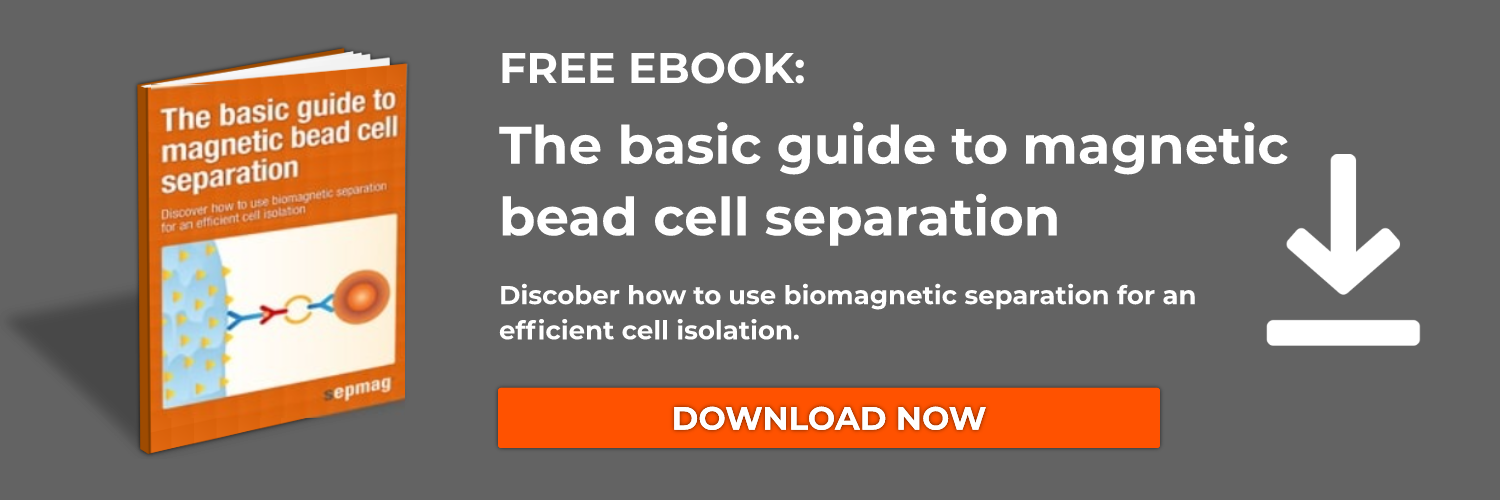During the last weeks we have reviewed several aspects of biomagnetic cell sorting, a process which facilitates the quick and targeted removal of specific cells from a heterogeneous solution. Cell sorting is essential for a number of purposes, from technological to investigative and biomedical. By harnessing the properties of magnetic beads, biomagnetic separation (BMS) allows cells to be isolated for additional downstream applications, without adversely affecting their form or function.

There are a number of advantages associated with the use of biomagnetic beads for cell sorting. The sensitivity of the beads makes the process suitable to small as well as large target cell populations, while maintaining a high degree of selectivity. The beads do not react with or alter the phenotype of their target, nor do they cause undue stress, as can occur with harsher separation techniques such as centrifugation. What’s more, the beads’ magnetic properties make them recoverable by magnets, a process which occurs within a rapid timeframe.
The potential for biomagnetic separation extends to a number of applications. In addition to immunoassays and immunoprecipitation, biomedical applications for BMS include isolation of ribonucleic acid (RNA), deoxyribonucleic (DNA) research and genetic exploration, biomicrofluidic-technologies, exosome analysis, bioassays, and tissue engineering. As research expands, the list of potential uses for biomagnetic separation will to continue to grow.
This article is about cell sorting protocols. If you are interested in knowing more about this process, download our free basic guide to magnetic bead cell sorting:
Designing a Biomagnetic Separation Protocol
In order to maximize the yield of a BMS process, it is essential to categorize the cellular targets. The specific properties of a cell form the basis by which it will be sorted. Intracellular properties - e.g., DNA, RNA, and proteins - and extracellular properties - e.g., morphology, size, and protein-expression - all impact the process. Categorizing cellular targets according to these characteristics will result in a focused approach to selecting magnetic beads for a particular process.
Cells are recognized and sequestered by biomarkers on the beads. Biomarkers, in turn, are attached via functional groups present on the beads’ surface. These surface functional groups may bind a biomarker covalently or non-covalently. Covalent binding confers a higher degree of selectivity, while non-covalent binding is more restrictive. The choice to use one type of binding over another will largely depend on the properties of the biomarker.
The size of the bead is another consideration when designing a protocol. Microbeads are generally preferred to smaller nanoparticles. In addition to being less susceptible to endocytosis, microbeads (>300 nm) have a tendency to interact with each other, accelerating the separation process and allowing the use of moderate magnetic gradients. In contrast, nanoparticles (<100 nm) must be separated individually, necessitating the use of higher gradients.
Because of this, the size of the particles will be a relevant factor informing the methodology. The type of method employed - i.e., High Gradient Magnetic Separation (HGMS) or Low Gradient Magnetic Separation (LGMS) - will affect several aspects of the process, including the devices employed. The high gradient required for HGMS, for instance, necessitates low-volume columns. LGMS, on the other hand, is carried out in containers ranging from microtubes to bottles or other containers.
During a biomagnetic separation process, the beads experience a magnetic force, drawing them in the direction of an applied magnetic field gradient. The magnetic force is generated as a result of the space varying field. The speed with which the beads are separated is determined by the force.
A sufficiently high magnetic field can saturate the beads. Depending on their concentration and size, it is possible for saturated beads to experience a dipolar interaction and aggregate to form chains or clusters. Clusters of beads are less affected by drag forces from the sample and have a higher magnetic moment. As such, they move faster than individual beads, significantly shortening the length of time required for a separation process.
A homogenous gradient ensures a non-varying magnetic force. Magnetic beads experience the same force and therefore move at the same speed, regardless of their distance from the magnet. This is not the case when the magnetic force is inhomogenous. In inhomogenous gradients, beads that are situated far from the magnet will be unsaturated, making clustering less likely and increasing the timescale of the separation. In addition, the parameters on which the magnetic field depends are more difficult to define, making inhomogenous systems more difficult to scale up.
A final factor relevant to the outcome of a BMS process is the type of magnet utilized to generate the magnetic field. Electromagnets are generally better suited to working with smaller volumes, as the heat generated by smaller magnets can be dissipated easily. Permanent magnets aren’t powered by electricity and therefore don’t require cooling systems, making them more suitable for larger volumes. In addition, permanent magnets maintain a magnetic field constant for tens of years. This is not the case for electromagnets, where the magnetic field depends on parameters such as current (and therefore the power supply precision and stability). The type of magnet chosen for a particular process will ultimately depend on the sample volume, process goals, and system methodology.
The success of a BMS protocol is reliant on the use of suitable biomagnetic beads and the application of an appropriate magnetic force. Within these parameters, there are a number of variables that can influence the process and affect the final outcome. When these factors are addressed, biomagnetic separation becomes a reliable and powerful technique for cell sorting and other biomedical applications, capable of efficiently targeting and sequestering cells without altering their essential characteristics.
Related articles:




